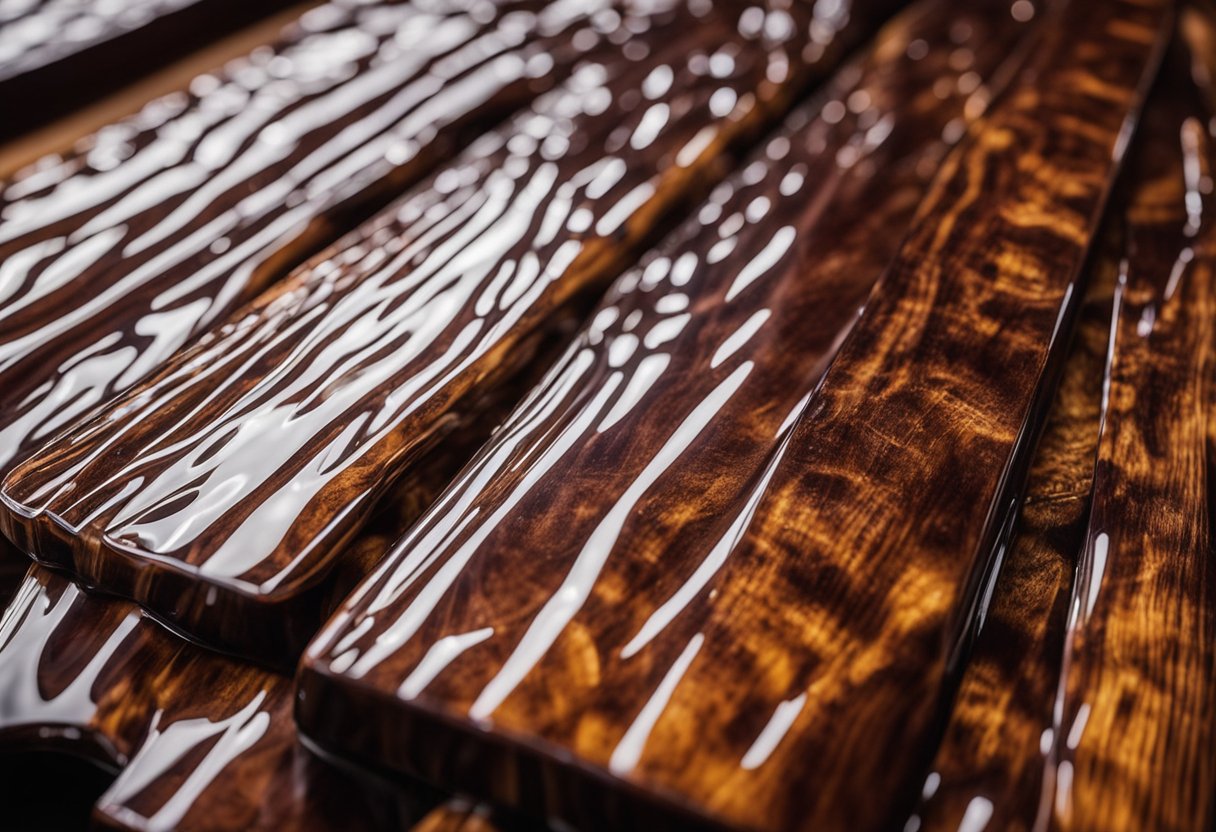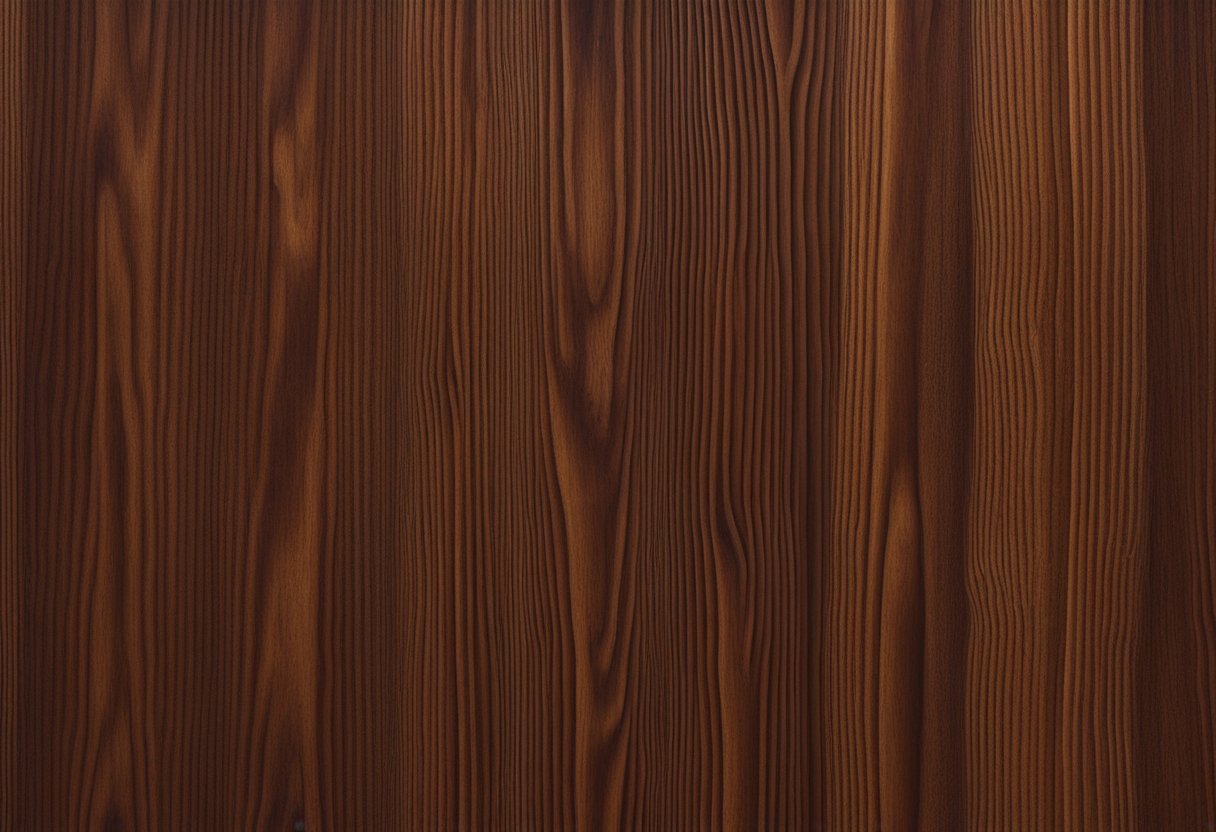I recently had the opportunity to experiment with garnet shellac on pine wood and I was pleasantly surprised with the results. Garnet shellac is a popular choice for finishing pine wood due to its rich, warm color that enhances the natural grain of the wood. In this article, I will share my experience with using garnet shellac on pine and provide some tips and tricks for achieving the best results.
Understanding shellac is crucial to achieving the desired finish on pine wood. Shellac is a natural resin that is harvested from the secretions of the lac bug. It has been used for centuries as a wood finish due to its durability, clarity, and ease of use. Shellac is available in a range of colors and can be mixed with other colors to achieve a custom shade. Garnet shellac is a popular choice for pine wood as it adds warmth and depth to the wood’s natural color.
Key Takeaways
- Garnet shellac is a great choice for finishing pine wood due to its rich, warm color that enhances the natural grain of the wood.
- Understanding shellac and its characteristics is crucial to achieving the desired finish on pine wood.
- Garnet shellac can be used to enhance the appearance of pine wood and provide a durable, long-lasting finish.
Understanding Shellac
https://www.youtube.com/watch?v=a1OCibJNAcg&embed=true
As a woodworker, I have found that shellac is a versatile and easy-to-use finish that can be used on a variety of woods, including pine. Shellac is a natural resin that is produced by the lac beetle, which feeds on tree branches and secretes a resin to protect itself from predators. This resin is harvested and processed into flakes, which can be dissolved in alcohol to create a liquid finish.
Shellac is available in a variety of colors, ranging from clear to dark brown, and can be used to enhance the natural beauty of wood or to add color. Garnet shellac, in particular, is a popular choice for adding warmth and depth to pine.
One of the benefits of shellac is that it dries quickly, allowing for multiple coats to be applied in a short amount of time. It also has a relatively short shelf life, so it is best to use premixed shellac or to mix it yourself from flakes as needed. Dewaxed shellac is recommended for use as a sealer or topcoat, as it is non-toxic and does not yellow over time.
When working with shellac, it is important to keep in mind that it can be cut with alcohol to adjust its consistency and drying time. It can also be applied with a variety of tools, including brushes, pads, and sprayers.
Overall, shellac is a versatile and easy-to-use finish that can be used to enhance the natural beauty of wood, including pine. Whether you are a beginner or an experienced woodworker, it is a great choice for adding color and depth to your projects.
Shellac Varieties and Their Characteristics
When it comes to finishing pine with shellac, there are several varieties to choose from. Each type of shellac has its own unique characteristics that can affect the final appearance of the finish. As an expert in wood finishing, I have extensive knowledge of the different types of shellac and their properties. Here are some of the most common shellac varieties and their characteristics:
Clear Shellac
Clear shellac is the most common type of shellac used for finishing pine. It has a natural, transparent appearance that allows the beauty of the wood grain to show through. Clear shellac is available in a range of shades, from light-blonde to super-blonde. It is also available in a bleached variety, which has a slightly whiter appearance.
Amber Shellac
Amber shellac has a warm, golden-brown color that can add depth and richness to pine. This type of shellac is often used on darker woods like walnut, cherry, and mahogany. It can also be tinted to create custom colors.
Garnet Shellac
Garnet shellac has a darker, reddish-brown color that is ideal for pine. It can add warmth and richness to the wood, while also highlighting the grain. Garnet shellac is a popular choice for antique restoration projects.
Orange Shellac
Orange shellac has a bright, orange hue that can add a pop of color to pine. It is often used on lighter woods like maple and birch. Orange shellac can also be tinted to create custom colors.
Tinted Shellac
Tinted shellac is a versatile option that can be customized to match any color. It is created by adding colorants to clear shellac. Tinted shellac can be used to create a range of effects, from subtle toning to bold color statements.
In conclusion, the choice of shellac for pine depends on the desired appearance and the type of wood being used. Clear shellac is the most common type of shellac, but amber, garnet, orange, and tinted shellacs can also be used to create unique finishes. As an expert in wood finishing, I recommend experimenting with different types of shellac to find the perfect finish for your pine project.
The Process of Applying Shellac on Pine
https://www.youtube.com/watch?v=pxc4juKGcTw&embed=true
When it comes to applying shellac on pine, the process can be relatively straightforward. The first step is to ensure that the wood is properly sanded and free of any debris or dust. Sanding can be done by hand or with a power sander, depending on your preference. Once the wood is smooth and clean, you can begin the application process.
The next step is to seal the wood. This can be done with a premixed shellac or with a seal coat. A seal coat is simply a thin layer of shellac that is brushed or sprayed onto the wood. This layer helps to prevent any stain or finish from penetrating too deeply into the wood, which can cause blotching or uneven coloring.
After the seal coat has dried, it’s time to apply the first coat of shellac. This can be done with a brush, pad, or aerosol can. Brushing is the most common method, as it allows for greater control over the application and ensures that the shellac is evenly distributed. It’s important to apply thin coats of shellac, as thicker coats can lead to drips, bubbles, and other imperfections.
Once the first coat has dried, it’s time to sand the wood again. This can be done with a fine-grit sandpaper or steel wool. Sanding helps to smooth out any imperfections in the finish and prepares the wood for the next coat of shellac.
The process of applying shellac on pine typically involves several coats. Each coat should be applied in thin layers, with ample time for drying between coats. The number of coats you apply will depend on the desired level of sheen and protection.
After the final coat has been applied and allowed to dry overnight, you can add a topcoat if desired. Polyurethane is a popular choice for a topcoat, as it provides a durable and protective finish. French polishing is another option for achieving a high-gloss finish, but it requires a significant amount of skill and experience.
Overall, applying garnet shellac on pine can be a relatively simple process. With the right tools and techniques, you can achieve a beautiful finish that highlights the natural beauty of the wood.
Enhancing the Appearance of Pine with Shellac
https://www.youtube.com/watch?v=RQ-FEtA0TKU&embed=true
As a woodworker, I have found that pine is a popular wood choice due to its affordability and workability. However, the light color of pine can sometimes be a drawback when it comes to finishing. That’s where garnet shellac comes in.
Garnet shellac is a popular choice for enhancing the appearance of pine. It is a type of shellac that has a warm, orange cast that gives a rich, antique-look to woodwork. When applied correctly, it can bring out the natural beauty of the wood grain and add depth and character to the finish.
One of the benefits of using garnet shellac on pine is that it can help to even out the color of the wood. Pine is known for its uneven coloration, with some areas appearing lighter or darker than others. By applying a coat of garnet shellac, you can help to create a more uniform color throughout the wood.
Before applying the garnet shellac, it’s important to prepare the wood properly. This may involve sanding the wood to create a smooth surface or using a wood conditioner to help the wood absorb the stain more evenly. It’s also important to choose the right type of shellac for the job. Garnet shellac is typically used for darker woods like mahogany, cherry, and walnut, but it can also be used on lighter woods like pine.
When applying the garnet shellac, it’s important to work in a well-ventilated area and to use denatured alcohol as a solvent. This will help to ensure that the shellac dries quickly and evenly. It’s also important to apply the shellac in thin, even coats and to allow each coat to dry completely before applying the next one.
In conclusion, garnet shellac is an excellent choice for enhancing the appearance of pine. It can help to even out the color of the wood, bring out the natural beauty of the wood grain, and add depth and character to the finish. By following the proper preparation and application techniques, you can achieve a beautiful, long-lasting finish that will make your pine woodwork stand out.
Troubleshooting Common Shellac Issues
https://www.youtube.com/watch?v=q4beb4eTszc&embed=true
As someone who has worked with garnet shellac on pine for a while, I have encountered a few common issues that can arise during the application process. Here are some tips on how to troubleshoot these issues:
Uneven Finish
One common issue with shellac is that it can result in an uneven finish. This could be due to a variety of factors, such as uneven application or substrate. To fix this issue, it is important to sand the surface thoroughly before applying the shellac. You can also try using a sealer to help even out the surface. Additionally, it is important to apply the shellac in thin, even coats, and to sand between each coat.
Orange Color
Another issue that can arise when working with garnet shellac is that the first coat can result in an alarmingly orange color. However, subsequent coats will improve the color to the expected garnet color. Of course, this depends on the color of the substrate as well [1].
Flaking or Peeling
If the shellac is flaking or peeling, it could be due to moisture or humidity. Make sure that the surface is completely dry before applying the shellac, and avoid working in high humidity environments. Another possible cause of flaking or peeling is an improper mix of shellac or a lack of solvent. Use a kitchen scale to measure the shellac flakes and solvent accurately, and mix them thoroughly.
Scratches or Damage
If the shellac has scratches or other damage, it is possible to repair it using the same shellac. Simply dissolve some of the shellac flakes in a solvent, and use a coffee grinder to grind the mixture into a fine powder. Then, use a fine cheesecloth to strain the mixture and apply it to the damaged area. Allow it to dry, and then sand lightly to blend it with the surrounding area.
Overall, garnet shellac is a great option for finishing pine, as it dries quickly and provides a beautiful, durable finish. However, it is important to troubleshoot any issues that arise during the application process to ensure a smooth and even finish.
Shellac Safety and Environmental Impact
As someone who works with shellac, it’s important to understand its safety and environmental impact. Fortunately, shellac is a non-toxic substance that is safe to use for most people. However, it’s important to take precautions when working with shellac in order to avoid any potential health risks.
One of the main concerns when working with shellac is the use of aerosol cans. While convenient, aerosol cans can be dangerous if not used properly. It’s important to follow the manufacturer’s instructions carefully and to work in a well-ventilated area to avoid inhaling any fumes.
In terms of environmental impact, shellac is a renewable resource that is harvested from the secretions of the lac bug. It is a natural substance that is biodegradable and does not contain any harmful chemicals. However, it’s important to dispose of any unused shellac properly, as it can be harmful to aquatic life if it enters waterways.
Overall, shellac is a safe and environmentally friendly substance to use for woodworking projects. By taking proper precautions and disposing of any unused shellac properly, you can minimize any potential risks and enjoy the benefits of this versatile finish.
Frequently Asked Questions
https://www.youtube.com/watch?v=Wa6e2kAQ63I&embed=true
How do you apply garnet shellac on pine?
To apply garnet shellac on pine, first, ensure that the surface is clean and free of any dust or debris. Then, mix the flakes with denatured alcohol to create the desired concentration. Apply the shellac using a brush or a pad, making sure to work in long, even strokes. Allow the shellac to dry completely before applying subsequent coats.
Can garnet shellac be used on pine furniture?
Yes, garnet shellac can be used on pine furniture. It is a popular choice for finishing pine due to its ease of application and ability to enhance the natural beauty of the wood.
What are the benefits of using shellac as a finish on pine?
Shellac is a versatile and durable finish that offers several benefits when used on pine. It is easy to apply, dries quickly, and provides a protective layer that helps to prevent scratches and other damage. Additionally, shellac enhances the natural beauty of the wood, providing a rich and warm finish that is both attractive and long-lasting.
Does shellac alter the natural color of pine?
Yes, shellac can alter the natural color of pine. However, this depends on the type of shellac used and the number of coats applied. Garnet shellac, for example, can darken the color of pine, bringing out its natural warmth and richness.
Is garnet shellac a good choice for finishing pine?
Yes, garnet shellac is a great choice for finishing pine. It is easy to apply, dries quickly, and provides a durable and attractive finish that enhances the natural beauty of the wood. Additionally, garnet shellac is resistant to moisture, making it an ideal choice for use in high-humidity environments.
How many coats of shellac should be applied to pine?
The number of coats of shellac that should be applied to pine depends on the desired level of protection and the specific type of shellac used. In general, however, it is recommended to apply at least two coats of shellac to ensure adequate coverage and protection. Additional coats can be applied as needed to achieve the desired level of finish.

Hi, I’m Sal Muller of Tooltrip.com. My DIY experience led me to understand essential power tools for home projects. Tooltrip.com guides enthusiasts and professionals in choosing right tools for any job. I provide concise top tool reviews for easier, efficient DIY.




